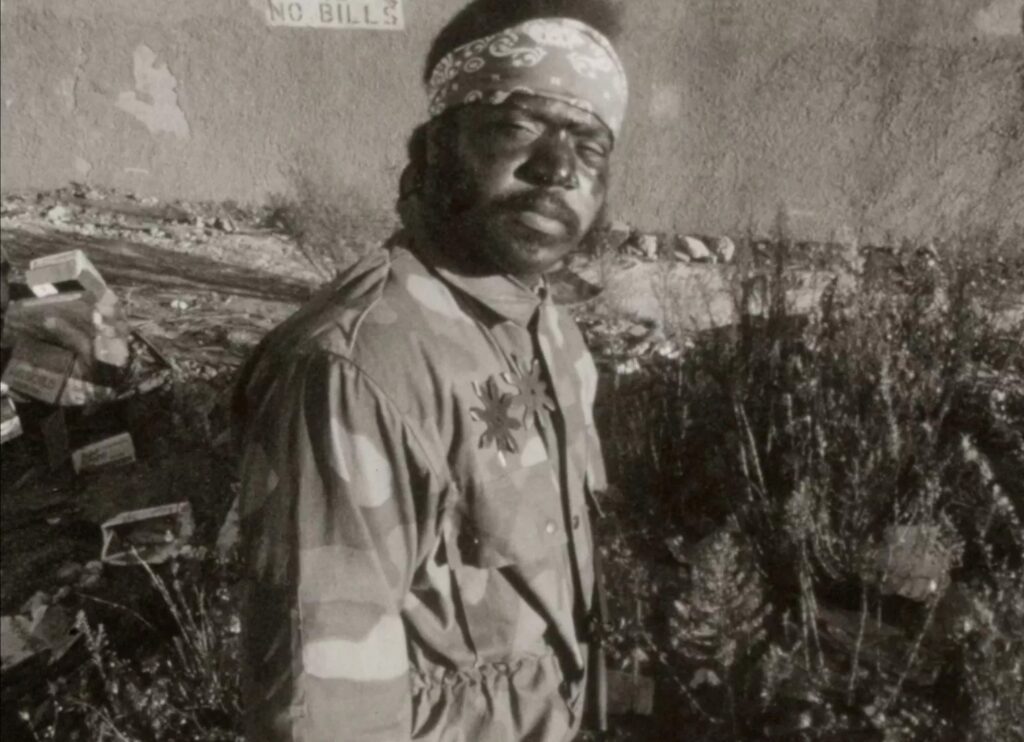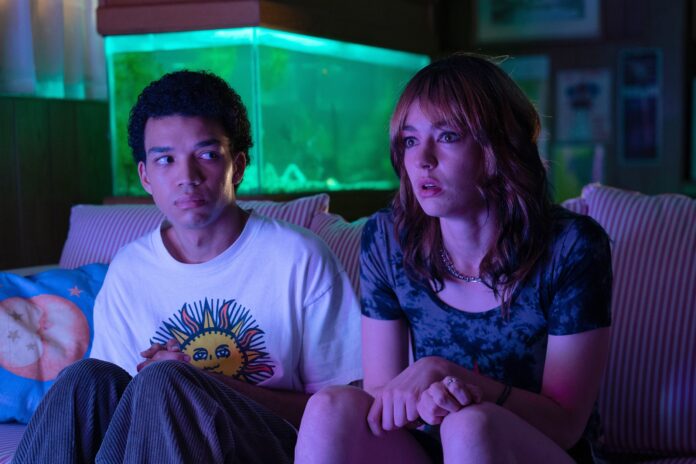Variations on “I’m too old for this” (usually with expletive attached) have been surfacing in usually-action-oriented movies for at least half a century, typically uttered by some exasperated macho hero who’s nonetheless about to handle the situation like the boss he is. However, sometimes the phrase is applicable to movies themselves, or rather to their viewer. I may never be old enough to enjoy something like Book Club, which seems pitched to the wealthy retirees of Palm Springs, Palm Beach, and Park Slope. But I am getting old enough that some films, even some entire filmmakers’ careers, seem a bit too… you know, Gen X/Y/Z to be related to.
At least I suspect that is the cause for an ambivalent reaction so far to the works of Jane Schoenbrun, a writer-director-producer in their mid-30s whose films are undeniably intriguing. But they also hinge on childhoods marinated in creepypasta mythologies, 1990s television, social media interactions, and a particular sort of adolescent-loner alienation clutched like a security blanket well into adulthood. Maybe recent generations should be divided by a different “A.D.,” this one not referring to the man from Galilee but meaning “After Digital.” It’s a whole ‘nother mindset—I’m still fairly analog by birth.
One of the more original lockdown features, Schoenbrun’s prior full-length narrative We’re All Going to the World’s Fair centered on an isolated teenage girl who communicates with a seemingly concerned adult man while playing “the internet’s scariest online horror game.” Does she become subject to some kind of curse as a result? Is mental illness at play? Or is she simply pranking this bystander as part of the role-play? For his part, is he the person he presents himself as, or some kind of closet predator? The film’s cipherous progress—all framed as Skype conversations and personal videos—could be interpreted as an expression of gender dysphoria, its horror-adjacent aspects metaphors for the psychological distress of an evolving identity.
Her new I Saw the TV Glow, which expands in Bay Area theaters this Friday (it opened last weekend at the Alamo and Kabuki), plays with overlapping themes on a larger scale. Owen (Ian Foreman) is a friendless 7th grader in the mid-1990s suburbs whose mother (Danielle Deadwyler) provides a thin protective barrier between him and his glowering father (Fred Durst!). He’s drawn to a fellow outsider in vaguely goth 9th-grader Maddy (Brigitte Lundy-Paine). Her main interest in life is a very weird ostensible children’s fantasy series called The Pink Oblique, in which two psychically linked teen girls battle an endless succession of supernatural foes.
They bond over that eccentric obsession, as well as the fact that Maddy, too, is in an unpleasant family environment she yearns to escape. She comes to believe it is possible to escape into her favorite show, i.e. actually entering its dimension. Yes, this becomes one of those “Be careful what you wish for” scenarios, at least in our protagonists’ minds.
Glow keeps leaping forward at erratic intervals, with Justice Smith taking over the role of Owen as he ages, his social isolation only worsening with the passage of time. But can that be attributed to his fear that “something is wrong with me”—again, there’s a suggestion of unresolved queer and/or trans coming-of-age—or is it because he, too, is now trapped in “the Pink Opaque’s” alternative universe?
This cryptic chronicle of creepingly bad feels rings some faint recognition bells, recalling David Lynch (it’s even got its own Julee Cruise in a humorless dreampop performance by Sloppy Jane), Videodrome, and other surreal-screen-nightmare reference points. But Schoenbrun’s sensibility is as distinctive as it is, well, opaque. Working with a real budget this time—even if $10 million is peanuts by Hollywood standards—she’s created a piece with sufficient commanding atmosphere and narrative mystique that to an extent it doesn’t matter how difficult it is to locate the substance beneath.
While the fadeout retains ambiguity, it raises the pitch of no-exit dread high enough to provide a satisfactory sense of climax. But until then, I was seldom sure which side of the fine line between compelling mystification and hollow “looka me I’m so daaaaark” posturing TV Glow stood. Judging from the kudos, Jane Schoenbrun is definitely speaking to her generation. But I might need an interpreter to grok just what they’re hearing.
A more grounded portrait of alienated youth can be found in Gasoline Rainbow, which opens at the Roxie this Fri/17. Like some of their prior features (including Bloody Nose, Empty Pockets and Tchoupitoulas), this latest from siblings Bill Ross IV and Turner Ross blurs the line between fiction and non-fiction cinema, casting “real” people more or less as themselves in a loose narrative. Here, those people are five teens who’ve just graduated high school, and collectively decide to embark on “one last adventure before we have to get jobs and shit.”
Pining for “a place for weirdos,” because “anywhere’s gotta be better than Wiley” (the made-up inland Oregon town they’re from), they climb into a van and head to the ocean 500+ miles west. Their trip—which soon must find other forms of transport—is always in search of a party, with that ease in making new friends a group of 18-year-olds may never enjoy so fully again. They meet fellow misfits and discards, refugees from broken homes, the heavily pierced and the endearingly open-hearted. We find out some things about our central protagonists. But they’re not particularly articulate, and they’re certainly not “explained” in any simplistic fashion—The Breakfast Club, this ain’t.
Gasoline Rainbow is redolent of other recent road movies like Nomadland and American Honey in its unstructured, semi-improvised feel, off-grid travelogue qualities, and diverse soundtrack. It has perhaps a bit less of their conspicuous reaching for an encompassing statement about America Now. These characters are still in their formative years, excited to experience new things. They have not yet experienced the kind of disillusionment that can harden into a world view. Their film is casual, but not self-indulgent, and crafted with care to make its somewhat wayward joyride sans specific destination (geographic or otherwise) feel like a journey that’s worth taking.

Other film events of note this week include three separate experimental showcases. Also at the Roxie, “Toney W. Merritt: As I Am” pulls together shorts from a 50-year span in the creative life of an SF Art Institute-trained, Healdsburg-based filmmaker whose frequently B&W ouevre encompasses dramatic abstractions (1974’s A Kiss of Death), self-portraits, goofs amongst friends, and an adaptation of Russian sci-fi author Stanislaw Lem (1985’s The Shadow Line). He’ll be present for a Q&A after both the Thu/16 and Sat/18 shows.
There’s a whole lot of gaudy color in SF Cinematheque’s “Avant-Barb(ie)” program at The Lab on Thurs/16. Co-presented with Microscope Gallery, “curated in response to and dialog with” Greta Gerwig’s multiplex vision, its fourteen film and video works also span half a century.
Highlights include Ava Bogle’s 2017 Meryl Fuckin Streep, in which a writing team pitch their screenplay to Hollywood producers whose sensibility is truly plastic; Lauren Kelley’s 2006 Big Gurl, which takes The Blonde One’s “ethnic” playmates into the realms of low-end employment and unplanned pregnancy; Pierre Bennu’s self-explanatory 2011 Black Moses Barbie (Harriet Tubman Commercial); and the 1995 Barbie’s Audition, wherein filmmaker Joe Gibbons anticipates the MeToo era by visiting every casting-couch sexual harassment scenario on guess-who/what. Like Todd Haynes’ Superstar, the latter is an ostensible joke that gets all too unsettling in its indictment.
Then there’s Other Cinema’s “Archive Fever” bill at ATA on Sat/18, whose main event is the West Coast premiere of found-footage wizard (Decasia, Dawson City: Frozen Time) Bill Morrison’s half-hour documentary Incident. It compiles surveillance, police dash-cam, and bodycam material (the latter released to the public under court order) of a 2018 altercation between Chicago cops and a barber walking home from work in a South Shore neighborhood. He was in the process of showing them his concealed-carry permit when the overexcited officers (most of them still trainees) panicked.
Needless to say, he died of multiple gunshot wounds, the police “forgot” to activate several of their own bodycams, and the only consequence to them was a couple wrist-slap suspensions. A complex split-screen assemblage sans any interpretive commentary, Incident is an infuriating must-see. Also on the program is Scott Calonico’s Everything You Wanted to Know About Sudden Birth* (*but were afraid to ask), a fascinating footnote about the story behind a 1966 police instructional film made in Berkeley.
If your feeling about all the above is “It’s summer now, more or less… so why would I want to be shut up inside with a movie?,” it should be mentioned that this weekend sees the return of SF Parks Alliance’s annual outdoor Sundown Cinema series. Free (though an RSVP is encouraged for prize eligibility) at seven city parks through Oct. 18, the series begins this Sat/17 with a sing-a-long Selena in Dolores Park, then encompasses SF-set faves (Bullitt, a “Lost Landscapes” program), much family fare (Labyrinth, The Princess and the Frog, The Nightmare Before Christmas)…and course Barbie. Full schedule and other info here.




